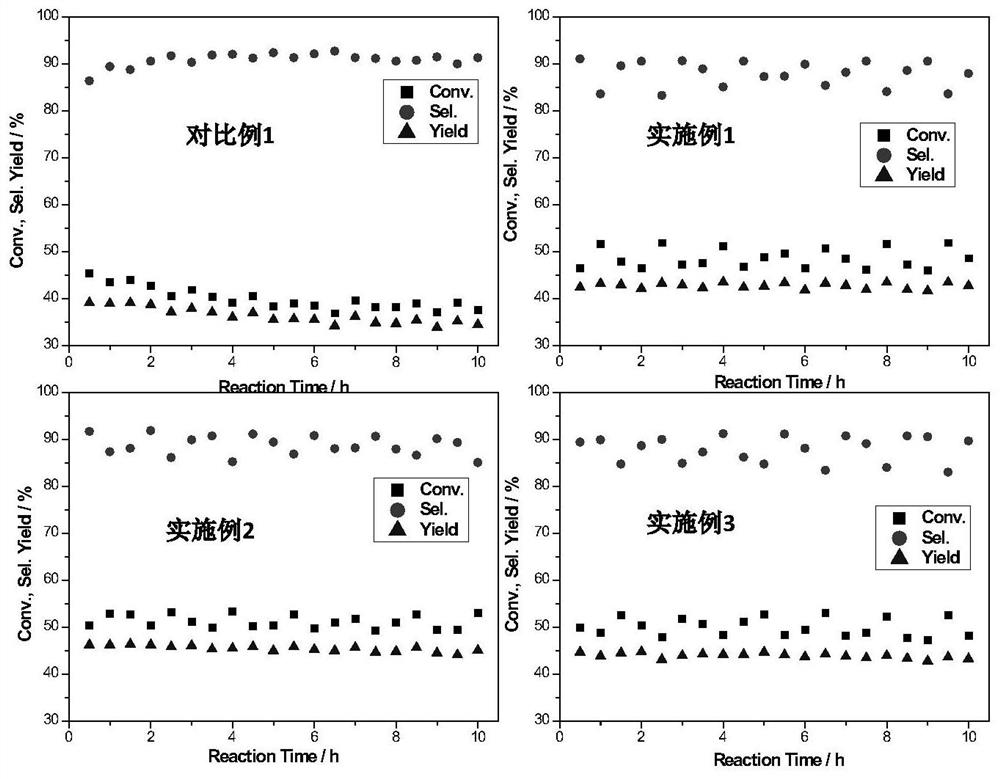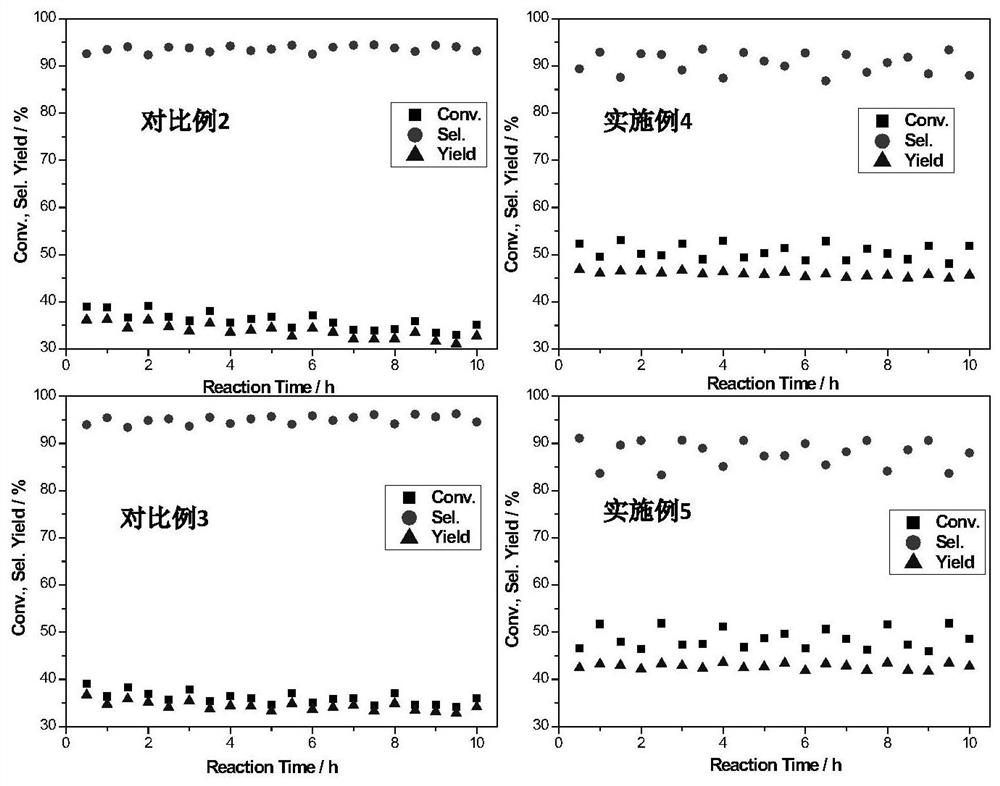Catalyst for preparing olefin by dehydrogenation of low-carbon alkane and preparation and application thereof
A technology for the dehydrogenation of low-carbon alkanes and alkanes, which is applied to catalysts for dehydrogenation of low-carbon alkanes to olefins and its preparation, catalyst preparation for yield and stability, catalyst preparation, and improvement of the conversion rate of low-carbon alkane dehydrogenation to olefins It can solve problems such as side reactions, catalyst deactivation, surface area carbon, etc., and achieve the effect of improving stability and olefin yield
- Summary
- Abstract
- Description
- Claims
- Application Information
AI Technical Summary
Problems solved by technology
Method used
Image
Examples
Embodiment 1
[0032] Preparation of Sn-Zn / ZnAl by Impregnation Method 2 O 4 vector. Take 2ml Zn(NO 3 ) 2 (0.05g Zn / ml) solution and 2.44ml (0.025gSn / ml) SnCl 4 The mass concentration of 10% dilute hydrochloric acid solution is put into a 200ml beaker, 4ml of deionized water is added, and the mixture is evenly mixed. 10 g of zinc-aluminum spinel pellets were weighed and added to the above solution, and placed for adsorption for 4 h. Drying at 60°C for 4h, drying at 120°C for 4h, and calcining at 550°C for 12h to obtain a catalyst carrier with dual promoters.
[0033] Take 10g of the above carrier and put it into a 250ml suction filter bottle and vacuumize for 0.5h. 1.35ml (0.037gPt / ml) of chloroplatinic acid solution and 2.4ml of 10% mass concentration of dilute hydrochloric acid were added. Drying at 60°C for 4h, drying at 120°C for 4h, and calcining at 550°C for 4h.
[0034] The prepared catalyst was then subjected to steam treatment at 550 °C for 4 h; then 5.6 ml of KNO was impreg...
Embodiment 2
[0038] Preparation of Sn-Zn / ZnFe by Impregnation Method 2 O 4 vector. Take 4.5ml ZnCl 2 (0.05g Zn / ml) solution and 2.44ml (0.025gSn / ml) SnCl 4 Put the diluted hydrochloric acid solution into a 200ml beaker, add 2ml deionized water, and mix well. 10 g of zinc-iron spinel particles were weighed and added to the above solution, and placed for adsorption for 4 h. Drying at 60°C for 4h, drying at 120°C for 4h, and calcining at 550°C for 12h to obtain a catalyst carrier with dual promoters.
[0039] Take 10g of the above carrier and put it into a 250ml suction filter bottle and vacuumize for 0.5h. 1.35 ml (0.037 gPt / ml) of chloroplatinic acid solution and 2.4 ml of 10% dilute hydrochloric acid were added. Drying at 60°C for 4h, drying at 120°C for 4h, and calcining at 550°C for 4h.
[0040] The prepared catalyst was then subjected to steam treatment at 550 °C for 4 h; then 5.6 ml of KNO was impregnated 3 (0.025gK / ml) solution was introduced into alkali metal additives, and t...
Embodiment 3
[0044] Preparation of Sn-Zn / ZnCr by Impregnation Method 2 O 4 vector. Take 9ml Zn(CH 3 COO) 2 (0.05gZn / ml) solution and 2.44ml (0.025gSn / ml) SnCl 4 The diluted hydrochloric acid solution was put into a 200ml beaker and mixed well. Weigh 10 g of zinc-chromium spinel powder into the above solution, and place it for adsorption for 4 h. Drying at 60°C for 4h, drying at 120°C for 4h, and calcining at 550°C for 12h to obtain a catalyst carrier with dual promoters.
[0045] Take 10g of the above carrier and put it into a 250ml suction filter bottle and vacuumize for 0.5h. 1.35 ml (0.037 gPt / ml) of chloroplatinic acid solution and 2.4 ml of 10% dilute hydrochloric acid were added. Drying at 60°C for 4h, drying at 120°C for 4h, and calcining at 550°C for 4h.
[0046] The prepared catalyst was then subjected to steam treatment at 550 °C for 4 h; then 5.6 ml of KNO was impregnated 3 (0.025gK / ml) solution was introduced into alkali metal additives, and the sample was dried at 120...
PUM
 Login to View More
Login to View More Abstract
Description
Claims
Application Information
 Login to View More
Login to View More - R&D
- Intellectual Property
- Life Sciences
- Materials
- Tech Scout
- Unparalleled Data Quality
- Higher Quality Content
- 60% Fewer Hallucinations
Browse by: Latest US Patents, China's latest patents, Technical Efficacy Thesaurus, Application Domain, Technology Topic, Popular Technical Reports.
© 2025 PatSnap. All rights reserved.Legal|Privacy policy|Modern Slavery Act Transparency Statement|Sitemap|About US| Contact US: help@patsnap.com



